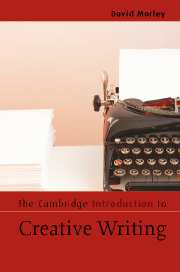Book contents
- Frontmatter
- Contents
- Preface
- Acknowledgements
- Chapter 1 Introducing creative writing
- Chapter 2 Creative writing in the world
- Chapter 3 Challenges of creative writing
- Chapter 4 Composition and creative writing
- Chapter 5 Processes of creative writing
- Chapter 6 The practice of fiction
- Chapter 7 Creative nonfiction
- Chapter 8 Writing poetry
- Chapter 9 Performing writing
- Chapter 10 Writing in the community and academy
- Illustrative bibliography
- Index
Chapter 8 - Writing poetry
Published online by Cambridge University Press: 05 June 2012
- Frontmatter
- Contents
- Preface
- Acknowledgements
- Chapter 1 Introducing creative writing
- Chapter 2 Creative writing in the world
- Chapter 3 Challenges of creative writing
- Chapter 4 Composition and creative writing
- Chapter 5 Processes of creative writing
- Chapter 6 The practice of fiction
- Chapter 7 Creative nonfiction
- Chapter 8 Writing poetry
- Chapter 9 Performing writing
- Chapter 10 Writing in the community and academy
- Illustrative bibliography
- Index
Summary
Behind several theories of what happens to a poet during the writing of a poem – Eliot's escape from personality, Keats's idea of informing and filling another body, Yeats's notion of the mask, Auden's concept of the poet becoming someone else for the duration of the poem, Valéry's idea of a self superior to the self – lies the implied assumption that the self as given is inadequate and will not do. How you feel about yourself is probably the most important feeling you have. It colors all other feelings, and if you are a poet, it colors your writing. It may account for your writing.
richard hugo, The Triggering Town: Lectures and Essays on Poetry and Writing (1979: 67)Where does rhythm come from? The cellular life of a poem is its language. All language naturally possesses rhythm, even non-human languages. Rhythm is made of beats, whether of a skin drum in a frog's throat, or a hoof's thrum. For living creatures, rhythm is used to create and defend territory, and communicate. Song is modulated in order to carry it best through resistant matter, as whale song is through the soft walls of ocean, or an owl's call spooling through woodland. The languages of most animals on our planet are based on sounds, and the sound carries the meaning. Rhyme and rhythm are not as artificial as you might suppose – they are natural mnemonics, occurring in birdsong and animal calls.
- Type
- Chapter
- Information
- The Cambridge Introduction to Creative Writing , pp. 194 - 214Publisher: Cambridge University PressPrint publication year: 2007

